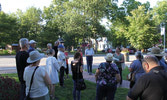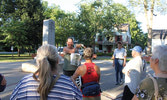Guided history walk commemorates the anniversary of the 1921 Great Fire of Aylmer
Greg Newing
Aylmer residents and visitors commemorated the anniversary of the Great Fire of Aylmer by participating in a guided historical walk on Wednesday August 10. The fire, which occurred just over 100 years ago on August 10, 1921 and which destroyed much of present-day Old Aylmer, is considered one of the most significant events in the sector’s history. The walk followed two earlier commemorative walks held on July 6 and 13.
The walk was led by Lynne Rodier, an Aylmer resident and PhD Candidate in Social Museology at UQO. Rodier has conducted extensive research on the history of Aylmer, and the Outaouais region more generally, and is a member of the Aylmer Heritage Association. Rodier’s love for Aylmer comes from her family roots in Old Aylmer which go back two generations. She was inspired to start the guided walks by the former president of the Aylmer Heritage Association, Micheline Lemieux, who passed away in March 2021, “My family was here and it started with curiosity,” said Rodier. “Micheline Lemieux told me about the fire and inspired me to start these walks.”
The event began at 6:30 pm at the Centre Culturel du Vieux-Aylmer at 120 rue Principale and finished at 8:00 pm at Saint Andrew’s Presbyterian Church on rue Symmes. Approximately 23 people participated in the walk despite Wednesday's heat.
What happened during the fire
The Great Fire of Aylmer started in the area around the British Hotel and quickly expanded to the northeast, engulfing two city blocks in flames. The fire moved up rue Principale, burning through the mostly wooden homes before stopping at what is now the Parc Commemoratif. The effects of the fire were catastrophic. 120 homes burned to the ground, 125 families were affected and 700 people were left homeless.
While the fire caused extensive property damage, there was only one death. Dominique George Lortie died while trying to save his horse from a stable. His great-granddaughter Monique Lortie, participated in Wednesday’s walk and shared some of his story, “My great-grandmother and great-grandfather were at a restaurant when the fire began,” she said. “When it broke out, my great-grandfather went to take care of the children and then went to the stable to save the horses where he was killed in the fire.”
Lortie also explained that her grandfather, the son of Dominique George Lortie, Telesphore G. Lortie, was the fire chief in 1921 and was on a trip to Trois-Rivières to purchase Aylmer’s first fire siren the same day that the fire broke out. He later served as city councillor from 1932-1944 and was Mayor of Aylmer from 1953-1959.
Showing incredible resilience, the people of Old Aylmer began to reconstruct their town the day after the fire. With winter only a few short months away, people felt the urgency to create housing. The Presbyterian Church had burned to the ground and families donated a brick at a time to support its swift reconstruction.
The origin of the fire is unknown to this day, but there are several theories on what may have caused it. One theory posits that the fire began from a spark from a nearby garage which blew into one of the many horse stables. Rodier said that what she would hear most often in her family growing up was that the fire started in a laundry facility where clothes were typically boiled over a fire.
While the great fire of Old Aylmer was the worst in Aylmer’s history, the damage could have been much more extensive. Rodier noted that the presence of trees and greenery in certain areas slowed the fire enough to give firefighters time to put out the blaze. She explained that while the fire burned quickly through the wooden buildings placed close together, it began to slow when it reached the comparatively humid green spaces. The trees in what is now the Parc commemoratif protected the houses east of the parc from being engulfed in flames. St. Paul”s Catholic Church was similarly protected from burning by the presence of greenery in a cemetery along Rue Couvent.
“If this story of the great fire has a moral to it, it is that we need to protect our trees and green spaces. Green spaces and tree coverage are a major protection against fire and we should make every effort to protect them,” said Rodier toward the end of the walk.
Symmes Inn exhibit
For those interested in learning more about the Great Fire of Aylmer, the Symmes Inn Museum has set up a special temporary exhibit about the fire and its significance for the history of Aylmer. The museum is located at 1, rue Front and is free for entry.
Caption – Image 1: Historian Lynne Rodier explaining the history of the Great Fire of Aylmer to residents. Photo credit: Greg Newing.
Caption – Image 2: Rodier speaking about the history of Old Aylmer in Parc Commemoratif. Photo credit: Greg Newing.



